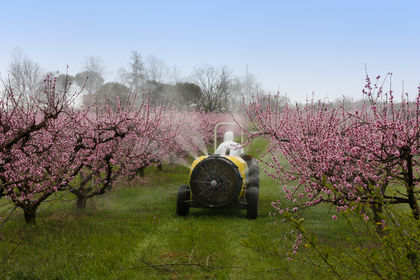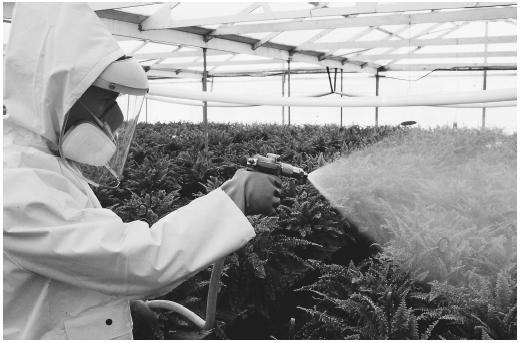Pesticides

Pesticides are chemicals that kill pests, and are categorized by the types of pests they kill. For example, insecticides kill insects, herbicides kill weeds, bactericides kill bacteria, fungicides kill fungi, and algicides kill algae.

Approximately 90 percent of all pesticides used worldwide are used in agriculture, food storage, or shipping. Because of a growing world population, there is pressure to increase and preserve the food supply by using pesticides and other agricultural chemicals.
History of Pesticides
Throughout history, various types of pests, such as insects, weeds, bacteria, rodents, and other biological organisms, have bothered humans or threatened human health. People have been using pesticides for thousands of years to try to control these pests. The Sumerians used sulfur to control insects and mites 5,000 years ago. The Chinese used mercury and arsenic compounds to control body lice and other pests. The Greeks and Romans used oil, ash, sulfur, and other materials to protect themselves, their livestock, and their crops from various pests. And people in various cultures have used smoke, salt, spices, and insect-repelling plants to preserve food and keep pests away.
Classes of Pesticides
Although the use of pesticides is not new, the types of substances people have used as pesticides have changed over time. The earliest pesticides were inorganic substances such as sulfur, mercury, lead, arsenic, and ash. Some of these inorganic pesticides are still used today. For example, sulfur is still used as a fungicide, copper is used as an algicide, lead and arsenic were used as insecticides until World War II, and chromium, copper, and arsenic have been used as wood preservatives to prevent microorganisms from causing wood decay. Even though many of these substances are effective pesticides, the use of some of these materials has been banned or restricted because of health and environmental concerns. Lead and arsenic are no longer used as insecticides, the use of mercury as a fungicide has been restricted, and the U.S. Environmental Protection Agency (EPA) is phasing out the use of arsenic as a wood preservative.
The modern era of chemical pest control began around the time of World War II, when the synthetic organic chemical industry began to develop. The first synthetic organic pesticides were organochlorine compounds, such as dichlorodiphenyltrichloroethane (DDT). Commercial production of DDT began in 1943. At that time, DDT was considered to be a wonderful invention. It was cheap to produce, very toxic to insects, and much less toxic to mammals. DDT and other organochlorine insecticides were used for many years to control mosquitoes and as a broad-spectrum insecticide against insect pests that damaged food and crops. Unfortunately, scientists learned later that many organochlorine insecticides were persistent in the environment (they did not degrade readily) and were bioaccumulating in birds, humans, and other animals. In 1962 Rachel Carson wrote the book Silent Spring, in which she reported that DDT was causing eggshell thinning in bird eggs and thus was leading to the near extinction of bird species such as peregrine falcons and bald eagles. Today most of the organochlorine pesticides have been banned in the United States by the EPA because of the tendency of these compounds to persist in the environment and bioaccumulate in animals.
Other classes of insecticides include the organophosphates, carbamates, pyrethroids, and biopesticides. These other classes of pesticides are not as persistent in the environment as the organochlorine pesticides. The organophosphate and carbamate pesticides affect the nervous system by disrupting the enzyme that regulates acetylcholine , a neurotransmitter. However, carbamate pesticides are less toxic to humans because their interactions with important enzymes are reversible. As a group, the organophosphate and carbamate pesticides are probably the most widely used insecticides, although many are being restricted by the EPA because of their toxicity.
Pyrethroid pesticides were developed as synthetic versions of the naturally occurring pesticide pyrethrin, which is found in chrysanthemums. Most pyrethroids are safer than the organochlorines, organophosphates, and carbamates, although some synthetic pyrethroids are toxic to the nervous system. Pyrethroids have been modified to increase their stability in the environment, and many different pyrethroids are being used today.
RACHEL CARSON (1907–1964)
The role of chemistry became irreversibly intertwined with the environment in 1962 when the term "ecosystem" was introduced in Rachel Carson's Silent Spring. One of four works written by Carson, it targeted the now banned pesticide dichlorodiphenyl-trichloroethane (DDT), spawning a movement that resulted in the formation of the U.S. Environmental Protection Agency (EPA).
—Valerie Borek
Biopesticides are substances that are derived from such natural materials as animals, plants, bacteria, and certain minerals. For example, canola oil and baking soda have pesticidal applications and are considered biopesticides. Biopesticides fall into three major classes, including microbial pesticides, plant-incorporated protectants, and biochemical pesticides. Microbial pesticides contain microorganisms, such as bacteria, fungi, and viruses, as their active ingredient. The most widely used microbial pesticides are strains of Bacillus thuringiensis, or Bt. Plant-incorporated protectants are pesticidal substances that plants produce from genetic material that has been added to the plant. Biochemical pesticides are naturally occurring substances that control pests by nontoxic mechanisms. Conventional pesticides, by contrast, are generally synthetic materials that directly kill or inactivate the pest. Biochemical pesticides include substances, such as insect sex pheromones, that interfere with mating, as well as various scented plant extracts that attract insect pests to traps. Because it is sometimes difficult to determine whether a substance meets the criteria for classification as a biochemical pesticide, the EPA has established a special committee to make such decisions.
Pesticide Residues
Pesticide residues are the materials that remain on plants and food when a crop is treated with a pesticide. The U.S. government establishes safe residue levels, called tolerances or maximum residue levels, for each food commodity. However, the presence of pesticide residues in food has been a public concern. There has also been a concern about pesticide residues in water, air, and soil. In response to this concern, the U.S. Congress passed the Food Quality Protection Act in 1996, which has had an impact on safety standards for pesticides.
Approaches to pest management have changed significantly since the 1950s and will continue to change as scientists learn more about the toxicity and environmental behavior of pesticides. Scientists will continue to develop newer approaches to insect pest management that are considered to be safer than the use of broad-spectrum pesticides. The most effective strategy for controlling pests may be to combine methods in an approach known as integrated pest management (IPM), which emphasizes preventing pest damage. In IPM information about pests and available pest control methods is used to manage pest damage by the most economical means and causing the least possible hazard to people, property, and the environment. Methods for pest management will continue to evolve as scientists conduct research and develop new information.
SEE ALSO Herbicides ; Insecticides .
Cynthia Atterholt
Bibliography
Cardé, R. (1990). "Principles of Mating Disruption." In Behavior-Modifying Chemicals for Insect Management: Applications of Pheromones and Other Attractants, ed. Richard L. Ridgway, Robert M. Silverstein, and May N. Inscoe. New York: Marcel Dekker.
Copping, L., and Hewitt, H. G. (1998). Chemistry and Mode of Action of Crop Protection Agents. Cambridge, U.K.: The Royal Society of Chemistry.
Cunningham, W., and Saigo, B. (2001). "Pest Control." In Environmental Science: A Global Concern, 6th edition. New York: McGraw-Hill.
Ecobichon, D. (1991). "Toxic Effects of Pesticides." In Casarett and Doull's Toxicology: The Basic Science of Poisons, 4th edition, ed. M. Amdur, J. Doull, and C. Klaassen. Elmsford, NY: Pergamon Press.
Farrell, K.; Flint, M.; Lyons, J.; Madden, J.; Schroth, M.; Weinhold, A.; White, J.; Zalom, F.; and Jaley, M. (1992). Beyond Pesticides: Biological Approaches to Pest Management in California: Executive Summary. Oakland: University of California.
Kydonieus, A., and Beroza, M. (1982). "Pheromones and Their Use." In Insect Suppression with Controlled Release Pheromone Systems, Vol. 1, ed. A. Kydonieus and M. Beroza. Boca Raton, FL: CRC Press.
Leonhardt, Barbara, and Beroza, Morton, eds. (1982). Insect Pheromone Technology: Chemistry and Applications. Washington, DC: American Chemical Society.
Lewis, D., and Cowsar, D. (1977). "Principles of Controlled Release Pesticides." In Controlled Release Pesticides: A Symposium, ed. Herbert Scher. Washington, DC: American Chemical Society.
Rice, R., and Kirsch, P. (1990). "Mating Disruption of Oriental Fruit Moth in the United States." In Behavior-Modifying Chemicals for Insect Management: Applications of Pheromones and Other Attractants, ed. Richard L. Ridgway, Robert M. Silverstein, and May N. Inscoe. New York: Marcel Dekker.
Scher, H., ed. (1977). Controlled Release Pesticides. Washington, DC: American Chemical Society.
Weatherston, I. (1990). "Principles of Design of Controlled-Release Formulations." In Behavior-Modifying Chemicals for Insect Management: Applications of Pheromones and Other Attractants, ed. Richard L. Ridgway, Robert M. Silverstein, and May N. Inscoe. New York: Marcel Dekker.
Wheeler, W. (2002). "Role of Research and Regulation in 50 Years of Pest Management in Agriculture." Journal of Agricultural and Food Chemistry 50:4151–4155.
Internet Resources
U.S. Environmental Protection Agency. "Pesticides." Available from http://www.epa.gov/pesticides .
Comment about this article, ask questions, or add new information about this topic: